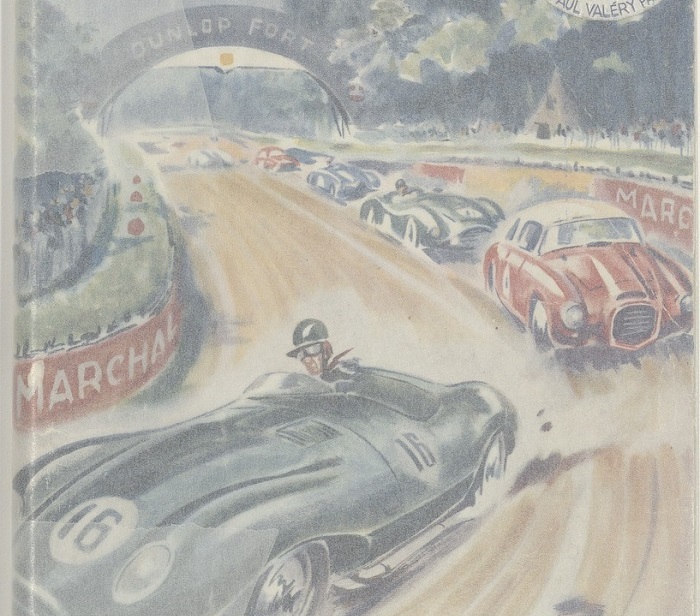The History of The 24 Hours of Le Mans Race (2 / 6)
Let's go racing : the history of The 24 Hours of Le Mans and its milestones will no longer hold any secrets for you.
Le programme officiel des 24 Heures du Mans, 1954, Bibliothèque municipale du Mans
With a big success among the public from its very first edition, The 24 Hours of Le Mans are organized every year, but in 1936 due to strikes and from 1940 to 1948 due to WWII and its consequences.
Starting from the 1924 edition, the race is organized in June and since then, as a tradition the race is held in the second weekend of June.
The growing notoriety of the endurance race attracted some big drivers of those times. As the first Formula One World Championship is officially organized starting from 1950, the teams and drivers used to participate in sprint races called Grand Prix (GP), some of them still organized today: Monaco GP (first edition in 1929), Pau GP (1933), Italian GP at Monza (1922), Belgian GP at Spa Francorchamps (1921) and others.
With a 100 km long at its beginning in 1906, the circuit has a new development starting from 1932 ( 13,492 km – quite close to the nowadays 13,626 km long La Sarthe non-permanent race track ).
The name of the Mulsanne and Arnage corners are given after the name of the villages located above the circuit. Indianapolis corner is a reminder of another famous international race: the 500 miles of Indianapolis, in the United States (first edition in 1911).
For the teams involved in the race, The 24 Hours of Le Mans are a big challenge in terms of organization: the preparation of the racecars, mechanical compounds, engines, gearboxes, suspensions and of the abovewould be used in extreme conditions during 24 hours. The tire suppliers would double their efforts in order to provide reliable and performant products. The mechanics and team members are working days and nights preparing the racecars for the start. The engineers are working on new parts, new concepts and innovations so that the cars would be more robust and reliable but in the same time quick and aerodynamic.
The drivers are preparing to face unexpected situations, like repairing the car on the track so that they can bring them back to the pits in case of trouble. They need to adapt their driving style for an efficient tire and fuel management.
The Loudspeaker and Broadcasting Station at the 24 Hours of Le Mans, June 14, 1931, Agence Rol
The race preparation and the evolution of the cars makes of Le Mans a real laboratory for the development of the new technologies and a real showcase for the car manufacturers.
Among the automotive brands, some got their name becoming famous, like Bentley (winner of five of the first eight editions: 1924, 1927, 1928, 1929 and 1930) but also Alfa Romeo (with four consecutive wins from 1931 to 1934). One of the two winners of the 1933 edition is the Italian Tazio Nuvolari, known as one of the best drivers ever.
The 24 Hours of Le Mans 1929 : Bentley, Barnato, Birkin, at speed, Agence Meurisse
The 24 Hours of Le Mans, 1929 : the Bentley team the start, Agence Meurisse
The 24 Hours of Le Mans, 1931 : the refueling at night, Agence Meurisse
But Le Mans has unfortunately its dramas and tragedies, like the 1955 catastrophe – the most serious crash in the motorsport history – a Mercedes is going airborne and landed into the public, killing more than 80 people plus its driver, the French Pierre Levegh.
Among the prestigious winners of the race are a few Formula One World Champions: Mike Hawthorn in 1955, Jochen Rindt in 1968, Graham Hill in 1972, but also nowadays with the Spaniard Fernando Alonso winner in 2018 and 2019.
There is a real competition also between the car manufacturers. During the first editions Bentley and Alfa Romeo shared most of the wins but Jaguar and Ferrari dominated the 50s and 60s editions just before Ford, Porsche and more recently Peugeot, Audi, Toyota.
See you next week for a new episode of The 24 hours of Le Mans.
See the French Version here

Cultural Olympiad is a multidisciplinary artistic and cultural program which runs from the end of the previous Games to the end of the Paralympic Games.
The Gallica series « Centenary of The 24 Hours of Le Mans » is part of the official Paris 2024 programming.








